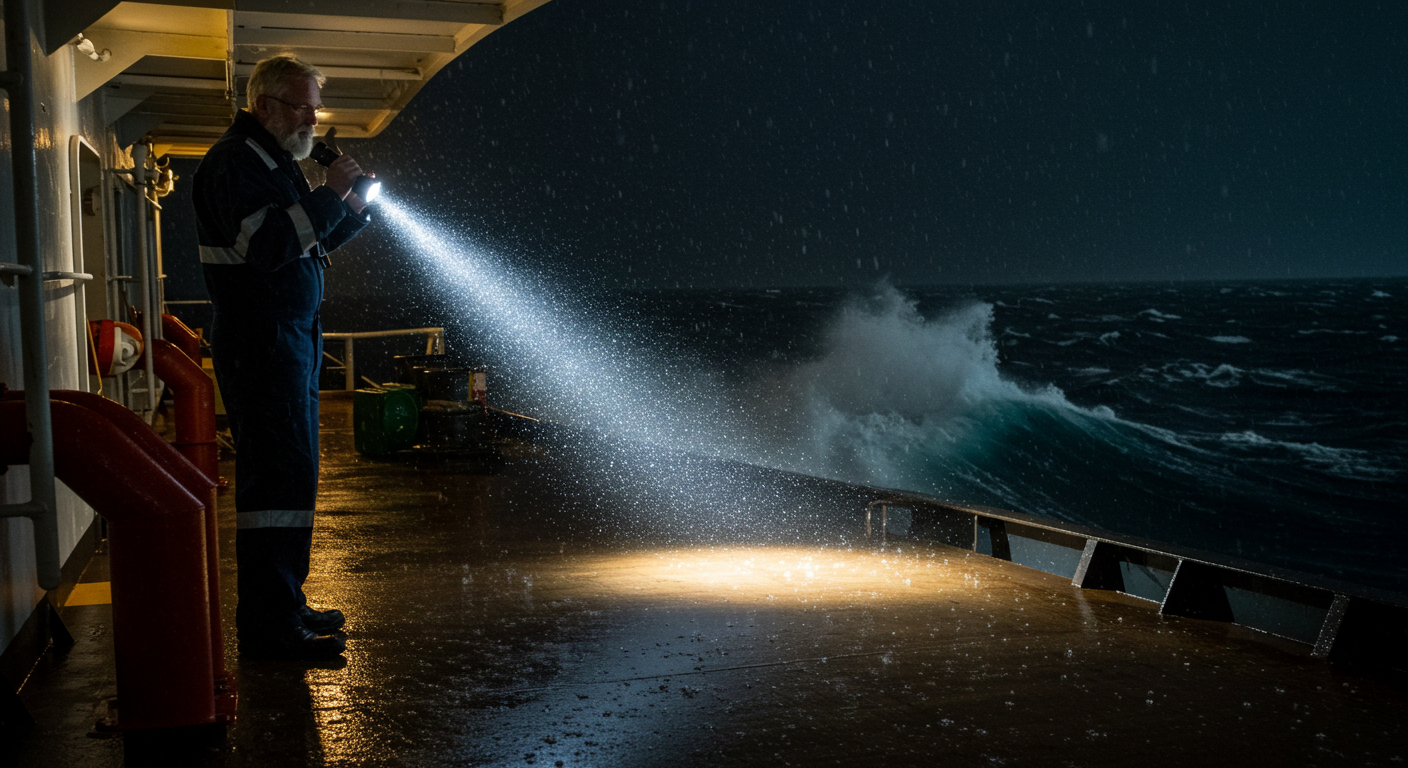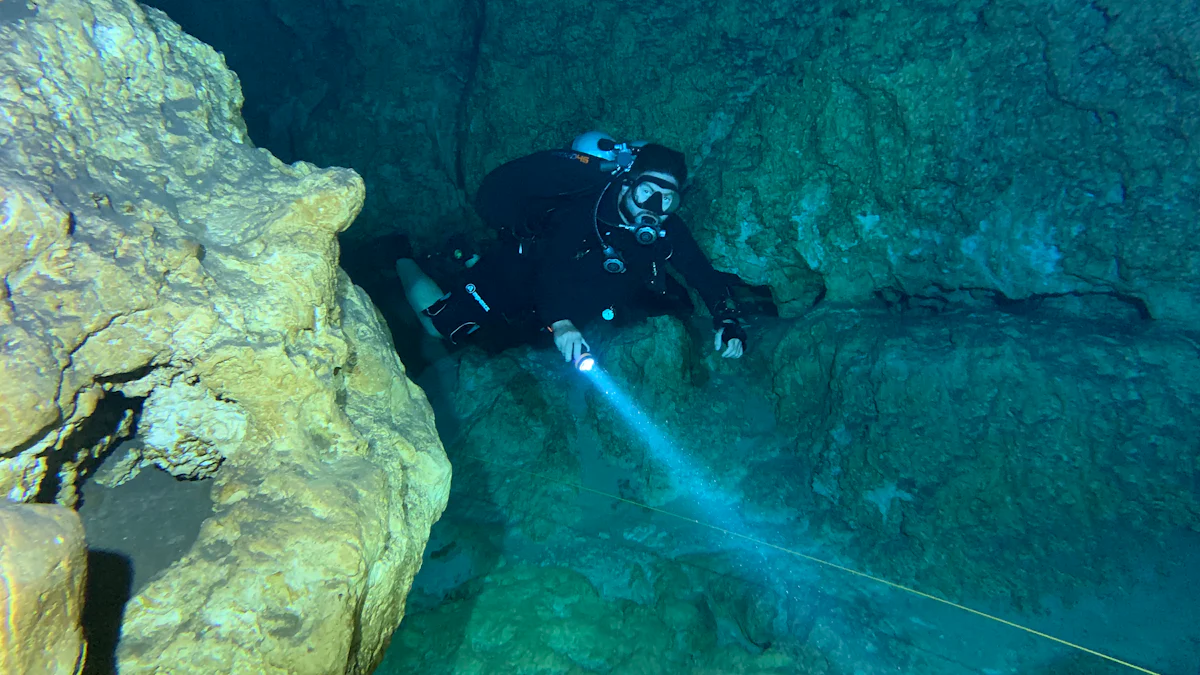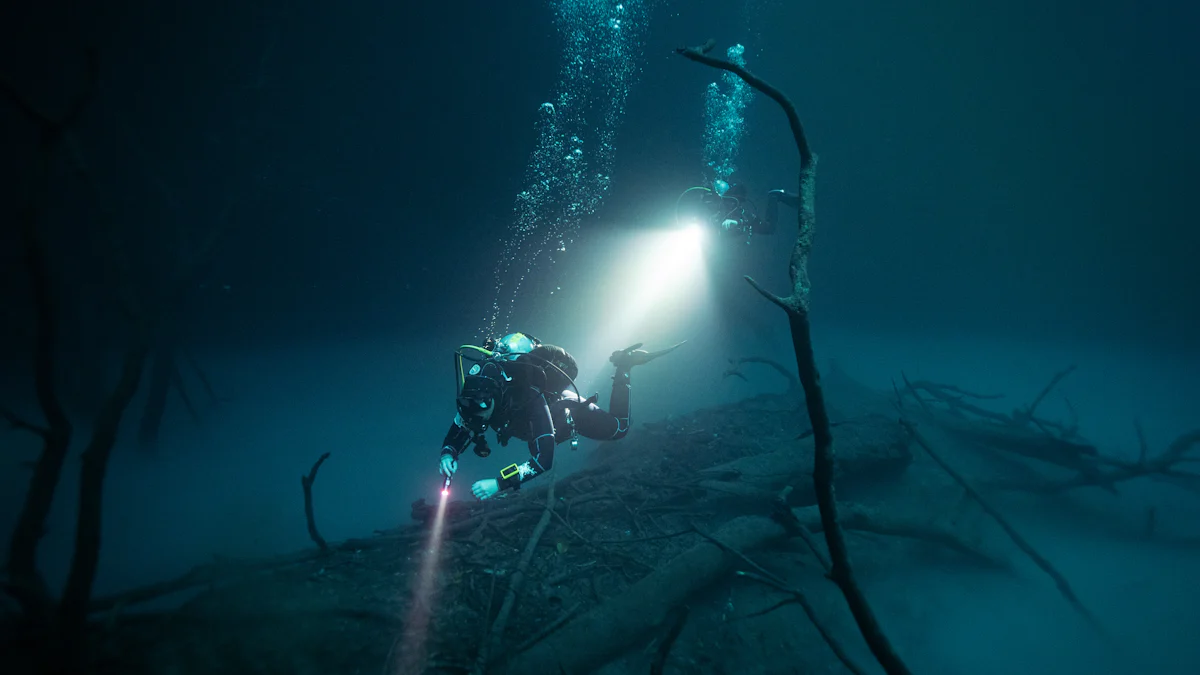Best flashlights for maritime use

A reliable maritime use flashlight plays a critical role in ensuring safety and efficiency during marine activities. You need dependable lighting to safely navigate at night, especially when working on deck or performing night operations. A good flashlight helps you locate channel markers and avoid floating debris, reducing risks during navigation. It also proves invaluable for illuminating engine bays or dark compartments, making maintenance tasks easier. Whether you're on a fishing trip or managing a vessel, a durable and bright flashlight ensures you stay prepared for any low-visibility situation.
Key Takeaways
Pick flashlights with high IPX ratings (IPX7 or IPX8). These are waterproof and work in heavy rain or water.
Go for flashlights with at least 1,000 lumens. This brightness helps you see better and stay safe on the water.
Choose strong materials like aerospace-grade aluminum. It resists saltwater and rough use, making it last longer.
Use rechargeable batteries for long trips. They save money and keep your flashlight working for a long time.
Think about your boating needs to pick the right flashlight. Spotlights help with seeing far, and headlamps free up your hands.
Key Features to Look for in Maritime Flashlights

Waterproofing
IPX ratings and their significance
When choosing a maritime use flashlight, understanding IPX ratings is crucial. These ratings indicate the level of water resistance a flashlight offers. Here’s a breakdown of the most common IPX ratings:
IPX4: Protects against splashing water, suitable for light rain.
IPX5: Handles low-pressure water jets from any direction.
IPX6: Resists strong water jets, ideal for rough waves.
IPX7: Submersible up to 1 meter for 30 minutes.
IPX8: Designed for prolonged submersion beyond 1 meter.
For maritime environments, IPX7 or IPX8 ratings are recommended. These ensure your flashlight remains functional even during accidental immersion or heavy rain. High IP ratings also help extend the lifespan of your flashlight by protecting it from saltwater corrosion and wear.
Importance of submersible flashlights for maritime use
A fully waterproof light is essential for marine activities. Waves, splashes, and sudden immersion can damage standard flashlights. Submersible flashlights, like those with IPX8 ratings, provide peace of mind. They perform reliably even when submerged, making them ideal for emergencies or underwater tasks. You can trust these lights to withstand the harsh conditions of the sea.
Brightness (Lumens)
Recommended lumens for maritime activities (1,000 lumens or more)
A high lumen rating ensures your flashlight provides adequate brightness for marine use. For most activities, 1,000 lumens or more is ideal. This level of brightness allows you to spot distant objects, navigate safely, and illuminate large areas. Whether you're fishing, sailing, or performing maintenance, a bright flashlight enhances visibility and safety.
How brightness affects visibility in fog and darkness
In foggy conditions, brightness can be a double-edged sword. Bright white lights often create glare due to backscatter, reducing visibility. Amber LED lights, on the other hand, minimize glare and penetrate fog more effectively. Their longer wavelengths make them a better choice for navigating in low-visibility conditions. For darkness, a bright flashlight with adjustable settings offers flexibility, allowing you to adapt to different scenarios.
Durability
Materials that withstand saltwater and rough handling
Marine environments demand flashlights made from durable materials. Aerospace-grade aluminum, for example, resists corrosion and physical wear. Some flashlights also feature anti-corrosion treatments, adding an extra layer of protection against saltwater. Stainless steel components, like switches, further enhance durability, ensuring your flashlight performs well even in harsh conditions.
Shock resistance and impact ratings
A floating waterproof flashlight should also withstand accidental drops and impacts. Look for models with shock resistance and high impact ratings. These features ensure your flashlight remains functional after rough handling or falls, making it a reliable tool for maritime adventures.
Battery Type and Life
Rechargeable vs. disposable batteries
When selecting a flashlight for maritime use, you need to decide between rechargeable and disposable batteries. Each option has its advantages and drawbacks:
Rechargeable Batteries:
Cost-effective over time, as they can be recharged multiple times.
Ideal for high-drain devices like powerful flashlights.
Require special charging equipment, which adds to your gear.
Pose safety risks if improperly stored, such as chemical leaks or fire hazards.
Contribute to e-waste and often rely on non-renewable energy sources.
Disposable Batteries:
Last longer initially, making them suitable for emergencies.
Perfect for low-drain devices that don’t require frequent use.
Cannot be reused, leading to higher long-term costs.
For extended maritime activities, rechargeable batteries are often the better choice. They reduce the need for frequent replacements and ensure your flashlight remains operational during long trips. However, keeping a set of disposable batteries as a backup can provide extra peace of mind.
Battery life considerations for extended use
Battery life is critical when you’re out at sea. You need a flashlight that can last through extended trips without frequent recharging or battery changes. Here’s a quick comparison of average battery lifespans:
Battery Type | Average Lifespan |
|---|---|
Deep Cycle Batteries | 2 to 5 years |
Lithium-ion Batteries | 10 to 20 years |
Trolling Motor Batteries | 2 to 5 years |
Lithium-ion batteries stand out for their longevity and reliability. They are a solid choice for flashlights designed for heavy-duty maritime use. Always check the manufacturer’s specifications to ensure the battery life aligns with your needs.
Portability and Design
Compact vs. full-sized flashlights
Compact flashlights are a game-changer for maritime use. Their smaller size and lighter weight make them easy to carry in your pocket or attach to a personal flotation device (PFD). Despite their size, many compact models offer impressive functionality. Some provide brief illumination for small tasks, while others act as waterproof spotlights capable of lighting up distant objects. These designs ensure reliability even in wet and challenging conditions.
Full-sized flashlights, on the other hand, deliver more power and longer battery life. They are better suited for tasks requiring extended use or higher brightness levels. However, their larger size can make them less convenient to carry. Choosing between the two depends on your specific needs and how much portability matters to you.
Ergonomic designs for easy handling
Ergonomic designs improve the usability of flashlights, especially in marine environments. Features like a comfortable grip and lightweight construction make extended use less tiring. For example, the Acebeam D20 2.0 offers a compact design with a durable stainless steel side switch. This switch allows you to adjust settings quickly, even in low-visibility conditions. Flashlights with ergonomic designs ensure you can handle them easily, whether you’re navigating rough waters or working underwater.
Top Flashlights for Maritime Use

Streamlight Waypoint 400
Key features: 1,000 lumens, long beam distance, waterproof
The Streamlight Waypoint 400 stands out as a versatile maritime use flashlight. It delivers an impressive 1,400 lumens of bright white light, ensuring excellent visibility even in the darkest conditions. Its IPX8 waterproof rating makes it reliable for marine environments, while its buoyant design prevents accidental loss in water. The flashlight also features three brightness settings—high, medium, and low—allowing you to adjust the light output based on your needs.
Feature | Description |
|---|---|
Brightness | Offers 1,400 lumens of vivid white light, enhancing down-range lighting capability. |
Water Resistance | IPX8 rating for waterproofing, making it suitable for maritime environments. |
Buoyancy | Designed to float, preventing loss in water. |
Durable Design | Built to withstand harsh conditions, ideal for maritime use. |
Weight Distribution | Balanced weight design reduces hand fatigue, beneficial for prolonged use by maritime workers. |
Pros and cons: Powerful beam, durable; slightly bulky
The Waypoint 400 excels in durability and brightness, making it one of the best boating flashlights. However, its slightly bulky design may not suit those seeking a compact option.
Price range: Mid-range
This flashlight offers excellent value for its features, falling within the mid-range price category.
Fenix HT18
Key features: High brightness, long-distance beam projection
The Fenix HT18 is a premium choice for those who prioritize brightness and range. It boasts a maximum brightness of 1,500 lumens and a beam distance of 925 meters, making it ideal for navigation and spotting distant objects. Constructed from durable aluminum alloy with a hard-anodized finish, this flashlight resists impact and corrosion, ensuring long-lasting performance. Its IP68 water resistance rating further enhances its reliability in harsh maritime conditions.
Pros and cons: Excellent for navigation; higher price point
The HT18’s exceptional brightness and durability make it a good boating flashlight for demanding tasks. However, its premium features come with a higher price tag, which may not suit budget-conscious buyers.
Price range: Premium
This flashlight is a top-tier option for those willing to invest in high-quality performance.
Princeton Tec Torrent Waterproof Dive Light
Key features: 500 lumens, submersible, compact design
The Princeton Tec Torrent is a compact yet powerful flashlight designed for underwater use. It features a 280-lumen Maxbright LED, making it suitable as both a backup and a primary light source. With a waterproof rating of up to 100 meters, this flashlight excels in various underwater scenarios, such as cave exploration and wreck diving. Its lightweight design ensures easy handling, even during extended use.
Feature | Specification |
|---|---|
Maximum Brightness | 280 lumens |
Burn Time | 30 hours |
Waterproof Rating | 100 meters |
Weight | 0.84 lbs (with batteries) |
Batteries | 8 AA Alkaline (Included) |
Pros and cons: Lightweight, waterproof; lower brightness
This flashlight’s compact size and waterproof design make it one of the best LED torches for sailors. However, its lower brightness may not meet the needs of those requiring high-lumen output.
Price range: Affordable
The Torrent Dive Light offers excellent performance at an affordable price, making it a great choice for budget-conscious users.
Dereelight Night Master
Key features: Small, lightweight, focused beam
The Dereelight Night Master is a compact flashlight designed for portability and precision. Its small size and lightweight build make it easy to carry, whether you’re on a boat or exploring the shoreline. This flashlight features a focused beam, which is perfect for tasks requiring concentrated illumination. Its design ensures you can pinpoint specific areas without wasting light on unnecessary surroundings. The Night Master is an excellent choice for those who value efficiency and portability in their maritime gear.
Pros and cons: Portable, efficient; limited beam spread
The Night Master’s portability is one of its standout features. You can easily store it in your pocket or attach it to your gear without adding bulk. Its focused beam is highly efficient for close-range tasks, such as inspecting equipment or reading charts. However, the limited beam spread may not suit activities requiring wide-area illumination. If you need a flashlight for broader visibility, this might not be the best option.
Price range: Mid-range
This flashlight falls within the mid-range price category, offering a balance between affordability and performance. It’s a solid investment for those seeking a reliable and portable flashlight for maritime use.
SureFire G2X Tactical Flashlight
Key features: Robust design, LED technology, durable
The SureFire G2X Tactical Flashlight is built to withstand the toughest maritime conditions. Its robust design includes a tough polymer body that resists corrosion, making it ideal for saltwater environments. The virtually indestructible LED emitter ensures consistent performance, even after prolonged use. With an IPX7 rating, this flashlight can handle accidental immersion in water, adding to its reliability. Its regulated output and runtime make it a dependable tool for various marine activities.
Feature | Description |
|---|---|
Body Material | Tough, lightweight polymer for corrosion resistance and durability |
Ingress Protection | IPX7 rating for liquid ingress protection |
Resilience | Can withstand punishment in any climate |
LED Emitter | Virtually indestructible, regulated for output and runtime |
Pros and cons: Highly durable; not submersible
The G2X Tactical Flashlight excels in durability. Its high-strength polymer body and IPX7 rating make it resistant to harsh conditions. You can rely on it for consistent performance in challenging environments. However, it is not fully submersible, which may limit its use for underwater tasks. Despite this, its durability and robust design make it one of the best boating flashlights for general maritime use.
Price range: Mid-range
This flashlight offers excellent durability and performance at a mid-range price point. It’s a great option for those who need a reliable flashlight without breaking the bank.
How to Choose the Right Flashlight
Consider Your Boating Activity
Fishing, sailing, or emergency use
Your choice of flashlight depends on your specific boating activity. Fishing often requires hands-free lighting, making headlamps a practical option. These allow you to focus on tasks like baiting hooks or untangling lines without holding a flashlight. For sailing, spotlights with over 1,000 lumens are essential for checking sail trim or navigating in low visibility. Emergency situations demand rugged, waterproof flashlights with SOS modes and long battery life. These features ensure you stay prepared for unexpected challenges during night operations or rough weather.
Flashlight features suited for each activity
Different activities call for specific flashlight features:
Spotlights: Ideal for focused tasks like navigation or search and rescue.
Flood Lights: Best for illuminating large areas, such as decks or cabins.
Headlamps: Perfect for hands-free use in tight spaces or on moving decks.
Red Light Functions: Preserve night vision and prevent blinding others.
Handheld Flashlights: Reliable as backups but not ideal as primary tools.
Budget Considerations
Balancing cost with quality and features
Balancing cost and quality ensures you get the most value from your flashlight. Flashlights under $30 often lack rechargeable batteries and advanced features. Models in the $70 range and above typically offer better LED efficiency, weatherproofing, and longer battery life. Higher-end options provide consistent lighting and advanced features like power regulators.
Best budget-friendly options
If you’re on a budget, consider these options:
Stanley Fatmax SL10LEDS: Compact, 2,200 lumens, priced at £72.
Lylting 90,000 Lumens Spotlight: Extremely bright, priced at £73.
Anhay 1200 Lumens Floodlight: Weather-resistant, priced at $23.
Duracell Floating LED Flashlight: Fully waterproof, priced at $25.
These models offer reliable performance without breaking the bank, making them some of the best boating flashlights for budget-conscious buyers.
Environmental Conditions
Flashlights for extreme weather and saltwater exposure
Marine environments expose flashlights to harsh conditions. Choose models with high IPX ratings to ensure durability. For light rain, an IPX4 rating suffices. Regular water exposure requires IPX6, while submersion calls for IPX7 or IPX8. Flashlights with corrosion-resistant materials, such as anodized aluminum or tough polymers, withstand saltwater exposure effectively.
Importance of corrosion resistance
Saltwater corrodes standard materials quickly. Flashlights designed for maritime use often feature anti-corrosion treatments or stainless steel components. These materials extend the lifespan of your flashlight, ensuring it performs reliably in extreme weather or during prolonged exposure to saltwater.
Choosing the right flashlight for maritime use ensures safety and efficiency. Focus on key features like waterproofing, brightness, durability, and battery life. For powerful illumination, the Streamlight Waypoint 400 offers exceptional brightness and reliability. If affordability is your priority, the Princeton Tec Torrent provides excellent value with its compact, waterproof design.
The Tektites Trek 400 floats beam-up, making it ideal for search-and-rescue. The Underwater Kinetics SL-4 Sun Light excels in brightness and ruggedness. For lightweight durability, the Pelican Recoil Stealthlite 2410 is a great choice. The Inova multi-diode X5 offers even light distribution for close-up tasks.
When selecting a flashlight, consider your environment, water exposure, and activity.
Spotlights: Perfect for navigation or night searches.
Flood Lights: Best for illuminating large areas.
Headlamps: Essential for hands-free tasks.
Evaluate your needs and pick a flashlight that matches your maritime activities. A well-chosen flashlight ensures you’re prepared for any situation.
FAQ
What is the best way to test a maritime flashlight?
You should test its waterproofing, brightness, and battery life. Submerge it in water to check for leaks. Use it in dark conditions to evaluate its beam strength. Testing spotlights and flashlights in real-world scenarios ensures they meet your needs.
How do I maintain a flashlight for saltwater use?
Rinse it with fresh water after exposure to saltwater. Dry it thoroughly to prevent corrosion. Store it in a cool, dry place. Regular maintenance extends its lifespan and ensures reliable performance.
Can I use a regular flashlight for maritime activities?
Regular flashlights lack waterproofing and corrosion resistance. They may fail in wet or salty conditions. Always choose a flashlight designed for maritime use to ensure safety and durability.
What is the ideal flashlight for emergency use on a boat?
Choose a flashlight with an SOS mode, long battery life, and waterproofing. Compact designs are easier to store. These features ensure you stay prepared during emergencies.
How do I choose between a spotlight and a floodlight?
Spotlights provide focused beams for long-distance visibility. Floodlights illuminate wide areas. Consider your activity—navigation benefits from spotlights, while deck work suits floodlights.
See Also
How Diving Flashlights Differ From Standard Flashlights
Explore Various Types of Flashlights Available Today
Choose the Ideal Flashlight for Daily Use
